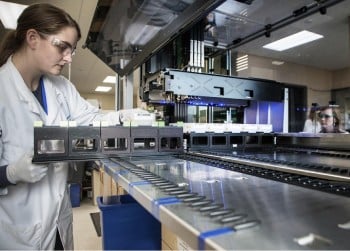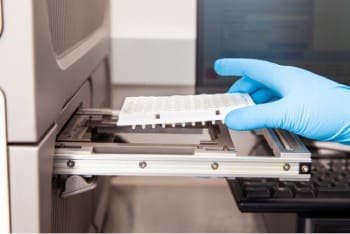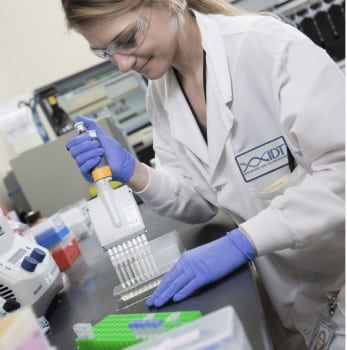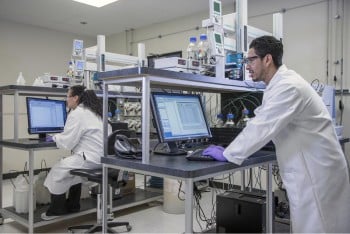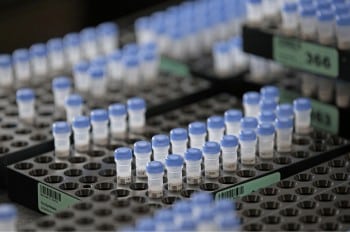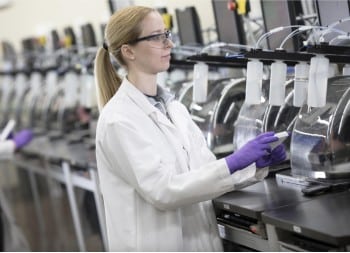In a previous DECODED article, we outlined the basics of CRISPR screening. CRISPR screening libraries cause disruption of genes, followed by changes in a known phenotype or response. These changes enable the identification of genes involved in the physiological effect being studied.
As described in our previous DECODED article in greater detail, CRISPR screening can be performed in either pooled or arrayed formats. Pooled screens involve production of a library of lentiviruses from a pool of DNA strands, each of which carries a different CRISPR targeting sequence. The library is used in pooled format to infect a large dish of cultured cells; subsequent analysis of the cells shows which genes are knocked out or phenotypically affected by the screen. Arrayed screens, conversely, can be easier to use. In the simplest arrayed approach, numerous chemically-synthesized guide RNAs (gRNAs), each in different wells of a multiwell plate, are complexed with Cas enzyme to form ribonucleoproteins (RNPs).
These RNPs are then transfected into cells in other multiwell plates, allowing one gene knockout per well. Both pooled and arrayed screens can be designed to target any number of sequences, and even to knock out every gene in an entire genome if desired.
Arrayed screens to confirm results of pooled screens
Pooled screens tend to be less expensive overall when compared to arrayed screens, so when very many genes (e.g., the genes of the entire human genome) are being investigated, the pooled format is usually chosen. However, arrayed CRISPR screens, targeting smaller numbers of genes, are frequently necessary for confirming the results of large pooled CRISPR screens, such as screens for drug sensitivity or drug resistance [1]. Such confirmatory arrayed screens may involve a few hundred targets. The arrays can be set up with one target per well (thus, for example, using 4 targets per gene would mean using 4 wells per gene). Alternatively, the array can combine several gRNAs—all targeting the same gene—in each well to enhance the possibility of the gene of interest being targeted by any or all of the gRNAs in the same well. This arrangement would therefore use only a single well for each gene to be knocked out. Either format may be useful for confirmation screens.
Benefits of arrayed screens in specific types of experiments
In addition to confirmation of the results from pooled screens, there can be other reasons for choosing to perform arrayed screens as well. For example, Kim et al. have shown that in some cases, arrayed CRISPR screens can be more accurate than pooled screens [2]. Their group has pointed out that when researchers knock out a gene that has only a minor effect, the loss of this small effect may not be observable when only a few cells in a large plate of cells have it. But when the gene is knocked out of most of the cells of the well, the cells in that well may have a clear phenotypic response [2].
Other researchers have pointed out that in some cell types, cells in culture can affect one another [3]. In particular, if one cell undergoes inflammatory processes or senescence due to a CRISPR screen, this damaged cell may cause death of nearby cells. This would confound the results of a pooled CRISPR screen, but in an arrayed screen the resultant cell death would all be confined to one well and thus still be attributable to the one gene known to be knocked out in that well.
Another reason arrayed screens may sometimes be more straightforward than pooled screens is if researchers wish to identify genes that contribute to a phenotype that is not necessary for cell survival. For example, arrayed screens can be used to identify genes involved in intracellular aggregation of proteins, electrophysiological phenotypes, morphological phenotypes, or extracellular secretion of specific compounds [3].
Arrayed screens offer safety and simplicity
In addition to the fact that arrayed CRISPR screens can have many experiment-specific advantages, yet another more general advantage of arrayed screens is that these screens allow researchers to avoid the use of lentiviral vectors with their inherently dangerous properties. It is not only this safety issue that is of interest, but arrayed screens also allow researchers to start with RNP. By avoiding the use of lentivirus and using RNP instead, no genomic integration of reagents takes place, thus preventing confounding factors due to such integration.
For Cas9 arrayed screening experiments, plated wells of gRNA can be obtained from IDT either as sgRNA or as shorter crRNA—which, for Cas9 experiments, can easily be annealed to tracrRNA. In most cases, either gRNA format (sgRNA or 2-part crRNA:tracrRNA) works exceptionally well. Cas9 can then be complexed with the gRNA to form RNP, which can be electroporated into cultured cells in a multiwell plate with, for example, a Lonza 4D-Nucleofector™ System. This approach to CRISPR arrayed screening has the additional advantage of removal of many obstacles involved in sample preparation.
IDT can accommodate custom gRNA libraries of large and small sizes for confirmation screens and other applications of arrayed CRISPR screening. We can provide the libraries in various formats: a single guide per well, pooled by target gene, or in a single pool. Thus, researchers can perform a very wide range of CRISPR screening experiments.
Arrayed CRISPR screening libraries
If you are interested in performing arrayed CRISPR screening in your own research, we can synthesize the libraries you need. Additionally, for pooled screens, oPools Oligo Pools are available.

